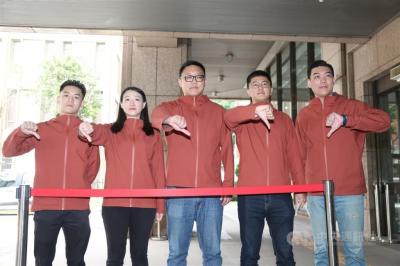A series of services and applications to facilitate the development of the nation’s green energy industry were launched by the Central Weather Bureau (CWB) and the Bureau of Energy yesterday.
The Meteorological Information-based Green Energy Operations Center Web site, which allows green energy operators to try the applications, was also launched.
The government has been actively promoting the use of solar energy, offshore wind energy and other renewable energy sources, CWB technology center director Lin Hsi-ming said.
Last year, 46.8 percent of electricity in the nation was generated by burning coal, followed by natural gas at 34.7 percent, Lin said, adding that renewable energy accounted for only 4.5 percent.
The government wants to elevate the contribution from renewable energy sources to 20 percent by 2025, Lin said.
Among renewable energy sources, 44.5 percent is generated by hydroelectric facilities, while wind and solar energy account for 14 percent and 13.9 percent respectively, so there is plenty of room to grow, Lin said.
Weather plays an important role in how wind and solar energy operators choose sites for power generators and how they forecast the amount of electricity needed to be generated, Lin said, adding that such information is also critical in helping operators dispatch power.
“The services developed by the two government agencies include an application to help green energy operators identify the locations with the highest green power density, which can be used as a reference when they need to choose sites for power generators,” Lin said.
Another app forecasts the green power that can be generated, which is used to assess the reliability of solar and wind energy over the subsequent three to seven days, Lin said.
This would also help the operators dispatch power and provide value-added services using smart grids, Lin said.
Industrial Technology Research Institute senior researcher Yen Chieh-cheng (顏厥正) said that the Bureau of Energy has developed an offshore power assessment system for different models of wind power generators to help operators decide how they want to arrange power generators in a wind farm.
It has also developed a system that allows power operators to dispatch and track wind power maintenance ships by combining information on the weather and shipping to help operators reduce maintenance costs, Yen said.
The Web site provides three types of information on wind and solar energy: historical averages, surveillance analyses and forecasts, the weather bureau said.
Preliminary analyses found that the ideal places to develop solar energy in the nation are the coastal areas in Yunlin and Chiayi counties as well as Tainan, which is the optimal location, the CWB said.
Wind energy can be developed off the coasts of Taichung and Miaoli and Changhua counties, as well as Oluanpi (鵝鑾鼻) in Pingtung County, it said.

Taiwan is stepping up plans to create self-sufficient supply chains for combat drones and increase foreign orders from the US to counter China’s numerical superiority, a defense official said on Saturday. Commenting on condition of anonymity, the official said the nation’s armed forces are in agreement with US Admiral Samuel Paparo’s assessment that Taiwan’s military must be prepared to turn the nation’s waters into a “hellscape” for the Chinese People’s Liberation Army (PLA). Paparo, the commander of the US Indo-Pacific Command, reiterated the concept during a Congressional hearing in Washington on Wednesday. He first coined the term in a security conference last

Prosecutors today declined to say who was questioned regarding alleged forgery on petitions to recall Democratic Progressive Party (DPP) legislators, after Chinese-language media earlier reported that members of the Chinese Nationalist Party (KMT) Youth League were brought in for questioning. The Ministry of Justice Investigation Bureau confirmed that two people had been questioned, but did not disclose any further information about the ongoing investigation. KMT Youth League members Lee Hsiao-liang (李孝亮) and Liu Szu-yin (劉思吟) — who are leading the effort to recall DPP caucus chief executive Rosalia Wu (吳思瑤) and Legislator Wu Pei-yi (吳沛憶) — both posted on Facebook saying: “I

The Ministry of Economic Affairs has fined Taobao NT$1.2 million (US$36,912) for advertisements that exceed its approved business scope, requiring the Chinese e-commerce platform to make corrections in the first half of this year or its license may be revoked. Lawmakers have called for stricter enforcement of Chinese e-commerce platforms and measures to prevent China from laundering its goods through Taiwan in response to US President Donald Trump’s heavy tariffs on China. The Legislative Yuan’s Finance Committee met today to discuss policies to prevent China from dumping goods in Taiwan, inviting government agencies to report. Democratic Progressive Party Legislator Kuo Kuo-wen (郭國文) said

The Ministry of Economic Affairs has fined Taobao NT$1.2 million (US$36,900) for advertisements that exceeded its approved business scope and ordered the Chinese e-commerce platform to make corrections in the first half of this year or its license would be revoked. Lawmakers have called for stricter supervision of Chinese e-commerce platforms and more stringent measures to prevent China from laundering its goods through Taiwan as US President Donald Trump’s administration cracks down on origin laundering. The legislature’s Finance Committee yesterday met to discuss policies to prevent China from dumping goods in Taiwan, inviting government agencies to report on the matter. Democratic Progressive Party